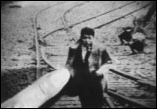|
|
 |
監督・撮影・編集:かわなかのぶひろ Director, Photography, Editing : Kawanaka Nobuhiro |
|
「私小説」は日本の近代文学のスタイルの主流である。小説におけるリアリズムは確かな個人的な体験にあるという前提に立っているのが「私小説」である。だから、私小説家が自分の生活体験や感情の記述に深入りしていくにしたがって、フィクションである小説のスタイルと実体験にもとづく「自伝」のスタイルはオーバーラップしていくものである。 このような手法は個人映画の作品にももちろん適用されるものだが、かわなかのぶひろの『私小説』は彼よりも若い世代で流行っているような“自分探し”的な手法とはまったく違うようだ。若手の作家たちがイメージというもの自体の不確かさに対してあまり疑問を抱かずに、自分の存在意義を見出すためにキャメラを自分自身に向けているのに対して、かわなかの作品は映画の中で自己をどのように描写するかという問題に立ち向かいながら、イメージと語りの境界線をはっきりと見せつけてくる。この『私小説』はかわなかの一連の「私小説」シリーズに新たな光をあてるとともに、かわなか自身の生活体験そのものよりも、むしろ映画的な方法でどれだけ「私小説」をたどっていけるかという問題に挑戦している。別々のテクストをリミックスして編集したり、過去に撮影した8mmフィルムをスローダウン、スピードアップしてスピード調整し、組み替えたりして、現在の視点から新しい作品を作り上げている。 時間(つまりフィルムのスピード)を調整し、過去と現在、実体験と語りを切り離していくという手法を用いることで、『私小説』は個人の記憶というフレームワークのなかで映画技法の実行演習をしているといえるだろう。なぜなら、映画という表現方法自体が記憶の表象であるからだ。このドキュメンタリー作品は時がたつにつれて残されていく人生の残像のあり方にこだわりをみせている。季節の移り変わりやヒトの移り変わり(寺山修司や川喜多和子、昭和天皇らの死)というテーマは、この映画の中心命題だといえるだろう。映画監督としてまた教育者として影響力をもつかわなかが、彼が過去に知り得てきた人々の表情を音声をかけずに淡々と記録していく方法、ほとんど無言で表現されていく『私小説』の方法は、彼の映画表現のイメージそのものなのだ。そして、「私小説」は再び彼の記憶となっていくのだ。 |
The " shishosetsu " or " I-novel " has been the dominant form of modern Japanese literature, one based on the assumption that realism in the novel can only be founded on authenticated personal experience. Fiction and autobiography thus overlap when the author concentrates on narrating his or her own life and feelings. The form is obviously adaptable to the personal documentary, but Kawanaka Nobuhiro's Shishosetsu differs from the " search-for-self-identity " prevalent in the work of his younger colleagues. While they turn the camera on themselves to confirm their own existence, rarely questioning the status of the image itself, Kawanaka's film always maintains a division between the image and its narration, devoting itself to the issue of how to write the self in film. Itself a new perspective on previous versions of the " Shishosetsu " series, Shishosetsu less relates Kawanaka's life than the cinematic traces of it, utilizing the mediating acts of editing together different texts and adjusting film speed to recombine, slow down, or speed up the 8mm films he has shot over the years, reading them anew from the present perspective. The adjustment of time (film speed) as a means of distinguishing
past from present, experience from its narration, makes Shishosetsu an exercise in personal memory in which cinema itself represents
the memories. The passing of the seasons and the passing away
of people (Terayama Shuji, Kawakita Kazuko, Emperor Hirohito)
provide the central motifs for a film deeply concerned with what
traces of life will remain as time goes by. For Kawanaka, a leading
filmmaker and educator, willfully recording the faces of everyone
he has known but presenting it in silence, it is the cinematic
image itself, his largely wordless appropriation of the " shishosetsu,
" which will be his memorial. |